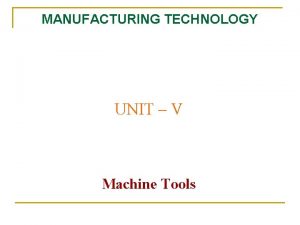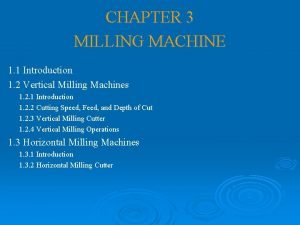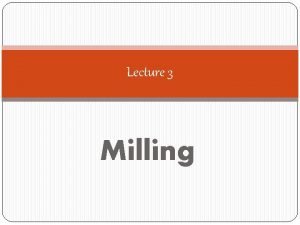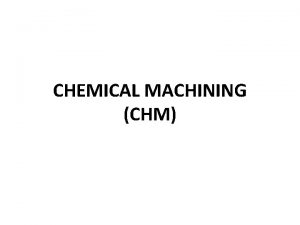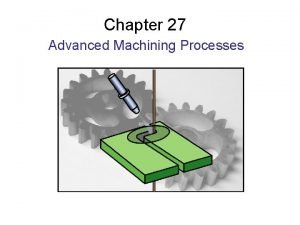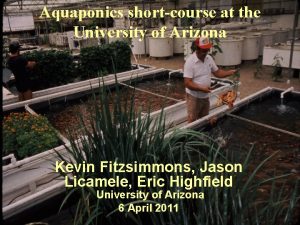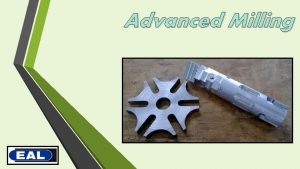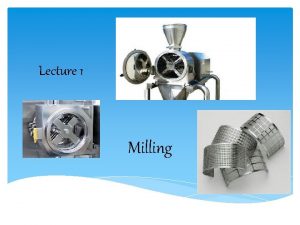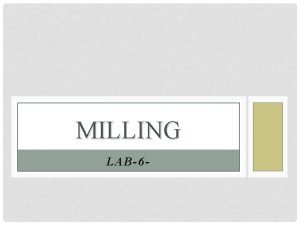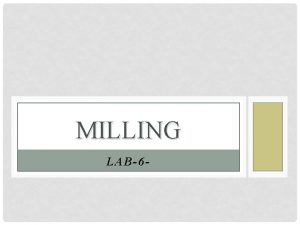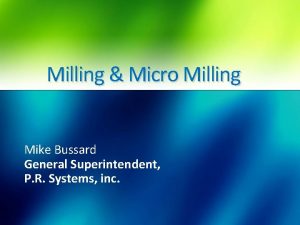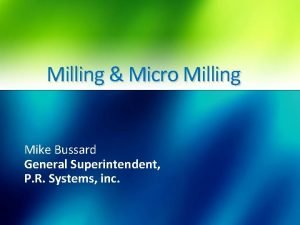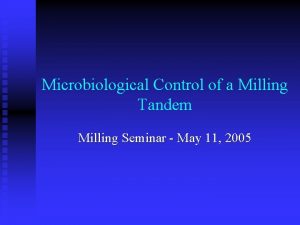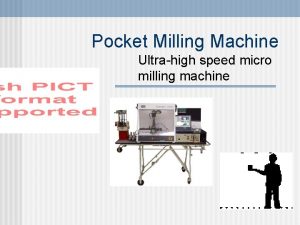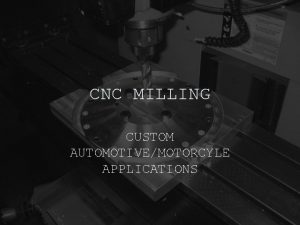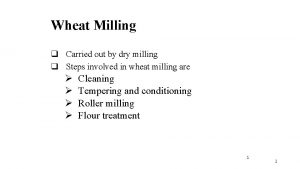Lecture 1 Milling Introduction Milling Is a mechanical




















- Slides: 20

Lecture 1 Milling

Introduction Milling: Is a mechanical process of reducing particle size of solids. Milling also termed synonymously as comminution which represent: Crushing Milling Disintegration Dispersion Grinding Pulverization All of these depend on product, equipment and process.

Introduction- Milling equipment classified according to the size of the milled product into: Coarse milling (particles > 20 -mesh) Intermediate (particles 200 - 20 mesh [74 -840 micron]) Fine (particles < 200 mesh) Note: Size expressed in term of mesh (number of openings per linear inch of a screen). e. g. : Hammer mill used to prepare a 16 -mesh granulation and to mill a crystalline material to a 120 -mesh powder.

Pharmaceutical Applications 1. Medicinal Powders A given weight of a finely powdered medicinal compound dissolves in a shorter time than does the same weight of a coarser powder. Due to Specific surface (surface area per unit weight) which Increased by size reduction By increasing the area of contact between solid and dissolving fluid Therapeutic efficiency of medicinal compounds that posses low solubility in body fluids.

Examples of Medicinal powders: Controlling fineness of Griseofulvin powder half (oral D. F. ) regimen. Small solid particles used to prepare solutions time required for dissolution is shorter. P. S. of oral suspensions affect texture, taste and rheology. Controlling P. S. and specific surface of Penicillin G procaine I. M. suspension Influence duration of adequate serum conc. , rheology and product syringeability. P. S. used in inhaled aerosols determines the position and retention of particles in the bronchopulmonary system.

2. Drying Milling facilitate drying of wet masses Increase surface area and reduce the distance the moisture travel within particle to reach outer surface. E. g. : Manufacture of compressed tab. , the granulation of wet mass result in more rapid and uniform drying Dried tablet granulation is milled to a P. S. and distribution that will flow freely and produce tablet of uniform weight. 3. Mixing Milling facilitate easier and uniform mixing or blending The ingredients are approximately of same size

4. Colored Pharmaceuticals are milled To ensure that the mixture is not mottled and is uniform from batch to batch. 5. Lubricants Should be milled to fine powder To ensure their ability to coat surface of powder or granules. 6. Ointments, creams and pastes Milling provide smooth texture, better appearance and improve physical stability.

Size Distribution and Measurement Natural particulate solids and milled solids Have Irregular shape and size (large-small) usually equivalent sphere. Thus Choosing the large particles by using microscopy (with similar surface or volume) i. e. 1 - Size of particle expressed in diameter (sphere) 2 - Volume of particle determined by displaced liquid (equivalent to diameter)

Sphere Volume = 4/3 * Pi * r³ = ( Pi *d³)/6 Equivalent diameter (Effective or Stock’s diameter) of an irregular particle i. e. sphere particle

Thus the effective or stock’s diameter used to determine rate of sedimentation (the time required for particle to settle between two fixed points in a suitable liquid). According to this the packing and flow of powder or granules depends on volume (effecting by size of particles - i. e. surface diameter -)

Representation of Data Milling of materials Bell shape structure Variety of particle sizes % Measurement of p. s. Determine percentage frequency of p. s. distribution Normal or Gaussian distribution (symmetric distribution about the vertical axis) The exception in reducing P. S. Increase No. of particles Skewed distribution)

Methods of Measurement of Size Distribution 1 - Microscopy 2 - Sieving 3 - Sedimentation 4 - Other methods (sorption, electrical conductivity, light and x-ray scattering, permeametry, and particle trajectory).

1 - Microscopy Direct Method for measuring P. S. distribution. Disadvantages: can’t resolve particles if it’s size is close to the wave length of the light source.

Types of Microscopes (1) Ordinary microscope (white light): measure particles 0. 4 - 150 microns. (2)Ultramicroscope: measure particles 0. 01 – 0. 2 micron. (3) Microscope with special lenses (UV light): measure particles 0. 1 micron.

Measuring Size of Distribution by Microscope 1 - Measuring size of particles (diameter) by using the calibrated filar micrometer eyepiece (graticule). 2 - Measuring No. of particles with the same size. Note: Recommended particles measured 625. If size of distribution wide (increase No. of particles). If not (narrow) few as 200 particle. 3 - Compare cross-sectional area of each particle (size of particles) through grids of circles or squares.

2 - Sieving Sieve: pan with bottom of wire cloth with square openings. Most widely method for measuring P. S. distribution. Advantages: Inexpensive, simple, rapid, limited variation between operators. Lower limit Mesh Micromesh (10 micron). (50 micron) Tyler standard [200 openings (mesh) per inch] U. S. standard [18 mesh per mm]

Size of distribution effected by: 1 - No. of Sieves (by passing powder through series of smaller sieves and weighing portion retained on each sieve). 2 - Motion of sieve (vibratory, side-tap, bottom-tap, rotary-tab, rotary). 3 - Time of sieving. 4 - Load or thickness of powder (proportional to time). Measuring diameter of powder bypass series of sieves: 30 -mesh and retained on 45 -mesh (diameter= 590 + 350)/2 or 470 microns.

3 - Sedimentation Method used to measure P. S. 1 -200 micron. Advantages: to obtained size- weight distribution curve and measuring P. S. This method depends on rate of sedimentation depends on P. S. - d Stock’s: effective or stock’s diameter. viscosity of dispersion fluid. x/t rate of sedimentation or distance of fall x in time t. - g is the gravitational constant. - p and po are the densities of the particle and the medium.

Pipet method (Anderson method) - P. S. distribution - Sphere particles Sample not exceeding 2% suspension powder put in suitable liquid in pipet and withdrawn at time intervals from specified depth and allow to settle down. (particles with different size fall at constant rate) with no interaction between particles that settle down. Larger particles fall at faster rate than smaller particles each time sample withdrawn has lower concentration and smaller particles in diameter than previous one.

 Up milling and down milling
Up milling and down milling 01:640:244 lecture notes - lecture 15: plat, idah, farad
01:640:244 lecture notes - lecture 15: plat, idah, farad Milling machine figure
Milling machine figure Actual mechanical advantage vs ideal mechanical advantage
Actual mechanical advantage vs ideal mechanical advantage Introduction to biochemistry lecture notes
Introduction to biochemistry lecture notes Introduction to psychology lecture
Introduction to psychology lecture Introduction to algorithms lecture notes
Introduction to algorithms lecture notes Indexing in milling machine
Indexing in milling machine Milling arbor types
Milling arbor types Prolight 1000 cnc mill
Prolight 1000 cnc mill Grinding
Grinding Plate jig
Plate jig Factors affecting milling process
Factors affecting milling process Milling theory
Milling theory Chemical milling layout
Chemical milling layout Chemical milling process
Chemical milling process Star milling fish food
Star milling fish food Dividing table worm ratio 1 40
Dividing table worm ratio 1 40 Rotary table milling
Rotary table milling Cutting speed for cast iron
Cutting speed for cast iron Milling ayoweng tagalog lyrics
Milling ayoweng tagalog lyrics
